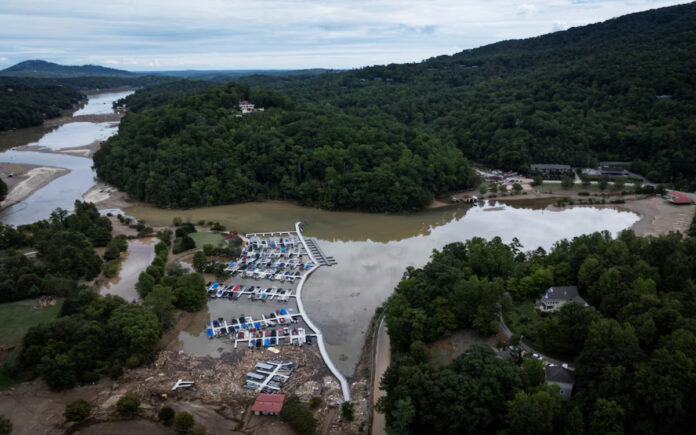Ashville: Search-and-rescue teams, having already saved hundreds, combed the rugged mountains of western North Carolina on Tuesday, seeking more survivors stranded by the devastation left by Hurricane Helene. Washed-out roads, destroyed bridges, and downed power lines complicated efforts, as emergency crews worked tirelessly in the aftermath.
Hurricane Helene has claimed at least 162 lives across North Carolina, South Carolina, Georgia, Florida, Tennessee, and Virginia, according to CNN, which cited state and local officials. The death toll is expected to rise as rescue teams reach isolated areas and communications are restored.
The toll in North Carolina’s Buncombe County alone surged to 57 fatalities on Tuesday, up from 40 the previous day. The county seat of Asheville and surrounding mountainous areas were hit hardest by the storm. U.S. Homeland Security Secretary Alejandro Mayorkas described the disaster as one of “historic magnitude.” He added that recovery efforts would be a “multibillion-dollar undertaking” that could take years to complete.
President Joe Biden, speaking with governors and local officials in the affected areas, vowed to expedite the recovery process. “People are scared to death. People wonder if they’re going to make it. We still haven’t heard from many people. This is urgent,” Biden said.
Hundreds remain missing, though officials expect that number to decrease as telecommunications are restored and more isolated regions are reached by emergency responders. The North Carolina National Guard has rescued more than 500 people so far, using helicopters to deliver supplies and evacuate survivors, including pets, Major General Todd Hunt said at a press briefing.
Among those lost to the storm was David Carver, 58, of McDowell County. Carver had been trying to divert water from his home in Linville Falls when a mudslide destroyed half of his house, sweeping him down a hillside. His friend and neighbor Ken Fisher, 60, rushed to help and found Carver trapped in a drainage pipe, pinned by debris.
Fisher stayed with him for 11 hours, pouring water over his face to clear the mud and praying with him. “I told him I wasn’t going to let him die there. I said, ‘I’m going to get you out,’” Fisher recalled. Despite Fisher’s efforts, Carver passed away in the hospital early Saturday from severe internal injuries.
Also Read | Typhoon Krathon Approaches Taiwan: Cities Shut, Flights Canceled
A Rare 5,000-Year Weather Phenomenon
Experts suggest some areas of western North Carolina experienced a rare 5,000-year weather event due to the extreme conditions that created intense rainfall. Tennessee state climatologist Andrew Joyner explained that a prior storm had pulled moisture from the Gulf of Mexico, saturating areas like Mount Mitchell, the highest point in the Appalachian Mountains. When Hurricane Helene arrived, its angle of approach forced it up the mountains, further intensifying rainfall. “The event was a perfect storm,” Joyner said.
Buncombe County Emergency Services Director Taylor Jones, surveying the damage in Swannanoa, echoed this sentiment. “This is a true disaster,” he told resident Ryan O’Keefe. “This isn’t going to be fixed quickly. This is not a sprint—it’s more like two or three marathons.”
Also Read | Starmer’s Brussels Visit Marks New Phase in UK-EU Relations
Power outages, which had peaked at 1 million in North Carolina, dropped to 420,000 by Tuesday, with only two hospitals in the western part of the state still relying on backup power, according to state Health Department Secretary Kody Kinsley. Access to drinking water systems remained limited. Across six states from Florida to West Virginia, 1.5 million homes and businesses were still without power as of Tuesday morning, Poweroutage.us reported.



